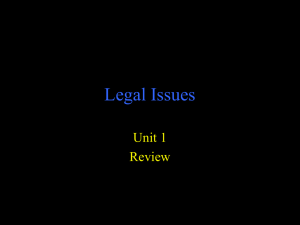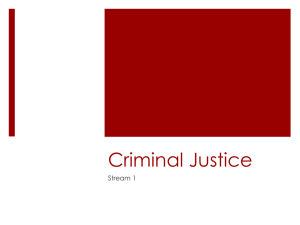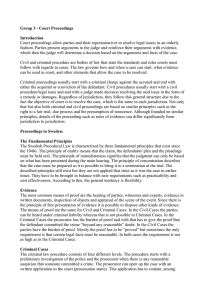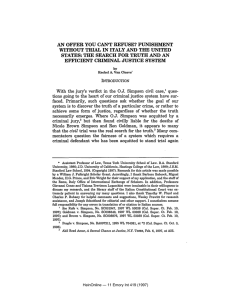Murphy - NYU School of Law
advertisement
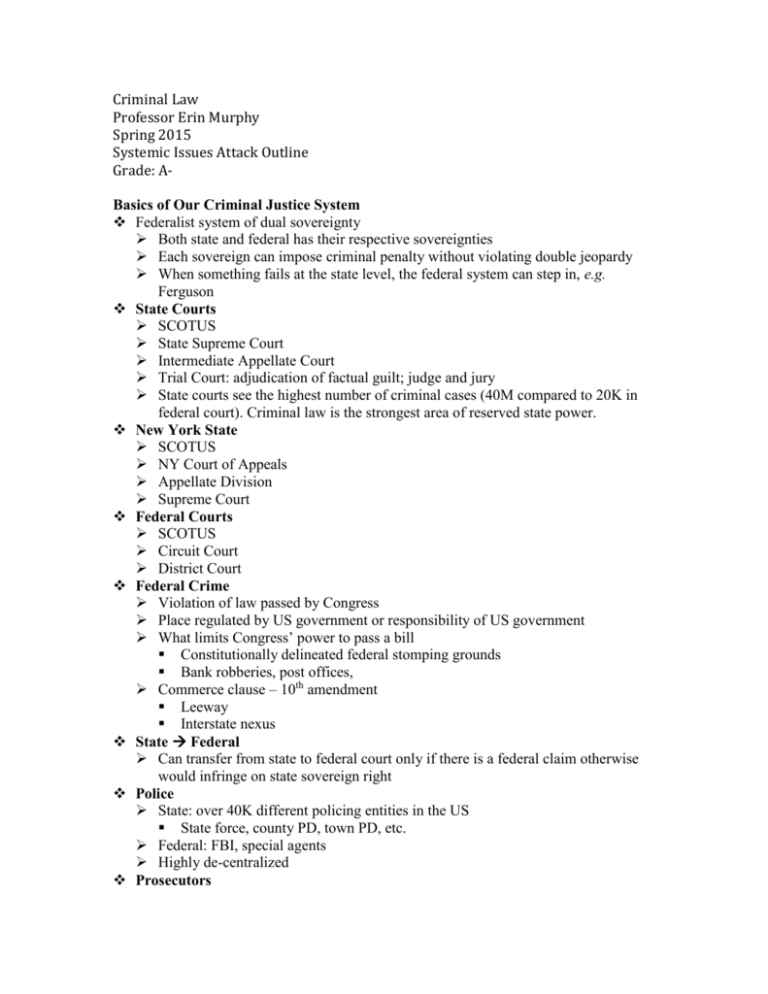
Criminal Law Professor Erin Murphy Spring 2015 Systemic Issues Attack Outline Grade: ABasics of Our Criminal Justice System Federalist system of dual sovereignty Both state and federal has their respective sovereignties Each sovereign can impose criminal penalty without violating double jeopardy When something fails at the state level, the federal system can step in, e.g. Ferguson State Courts SCOTUS State Supreme Court Intermediate Appellate Court Trial Court: adjudication of factual guilt; judge and jury State courts see the highest number of criminal cases (40M compared to 20K in federal court). Criminal law is the strongest area of reserved state power. New York State SCOTUS NY Court of Appeals Appellate Division Supreme Court Federal Courts SCOTUS Circuit Court District Court Federal Crime Violation of law passed by Congress Place regulated by US government or responsibility of US government What limits Congress’ power to pass a bill Constitutionally delineated federal stomping grounds Bank robberies, post offices, Commerce clause – 10th amendment Leeway Interstate nexus State Federal Can transfer from state to federal court only if there is a federal claim otherwise would infringe on state sovereign right Police State: over 40K different policing entities in the US State force, county PD, town PD, etc. Federal: FBI, special agents Highly de-centralized Prosecutors State: District Attorney (elected or appointed), ADA’s Federal: AUSA’s, appointed by POTUS Bear the burden of proof “beyond a reasonable doubt’ Attica v Rockefeller: after a prison uprising the prisoners allege abuse and want the court to force prosecution. Court says statute does not preclude prosecutorial discretion and that it’s always present. Multiple reasons why you would not prosecute: insufficient evidence, security, credibility, resources, conflict of interest, bias, etc. Bordenkircher v Hayes: ∆ claims vindictive prosecution under 14th Amendment, prosecutor says if he doesn’t take plea deal then he’ll seek a life sentence under habitual offender statute, court says it was fine because of prosecutor’s desire to save resources, describes it as a “mutuality of advantage,” court is unconcerned with proportionality of the punishment Plea Bargaining: Defendant has to be able to make a choice that is knowing, intelligent, and voluntary. If prosecutors make threats they don’t follow through with then the system falls apart because all of this is public Defense Lawyers Retained Counsel No pay-off like in civil litigation Appointed Counsel Provided by the state Pro bono/ad hoc Plucked, list, etc. Public Defenders Judges Elected or appointed Quasi-election, quasi-party loyalty Probation Still under the supervision of the judge Probation officer who reports to judge Parole “Supervised release” Reporting to the correction agency United State Prison Population Federal: mostly felonies, mostly drug crimes, spike in immigration detention State: mostly misdemeanors, half violent; entering population is evenly divided 5% of world population, 25% of global prisoners Highest rate of incarceration As states reexamine, the numbers drop, but federal prisons have been slower to reexamine Black and Latino populations Male Poor, uneducated Addiction, mental health, physical health issues Crime rate declining at an unprecedented rate Charging and Discretion Severity & certainty (Bentham)—if these are out of whack or arbitrary then the system loses its legitimacy Misdemeanor Justice State level, lower than 1 year sentence v. felony, more common federally (1+ year) Low level misdemeanors are clogging the system Hamlin – misdemeanor defendant’s get public defenders Delay directly linked to getting counsel Misdemeanors always waive right to council Seems to operate more like an assembly like and in aggregate Convictions often turn on wealth, tenaciousness The consequences are not proportional to the time given to the case Maybe we should reconceptualize what is criminal Debtor’s prisons are illegal unless they have capacity to pay, which causes problems Collateral Consequences Most states allow employers to deny jobs to people who were arrested but never convicted of a crime. All but two states restrict the right to vote in some way for people with criminal convictions. Many public housing authorities deny eligibility for federally assisted housing based on an arrest that never led to a conviction. Most states ban some or all people with drug felony convictions from being eligible for federally funded public assistance and food stamps. 4 states – Colorado, Delaware, Massachusetts, and South Carolina – revoke or suspend drivers’ licenses for longer than six months for drug convictions unrelated to driving. Sentencing Usually judge’s role Used to be entirely discretionary, which was unpredictable and problematic. Then transitioned to sentencing guidelines, which were also problematic. Now the guidelines have been relegated to advisory capacity only. Cabined by statutory requirements or guidelines (“our state cares about rehabilitation”) Length – law has little traction here, inconsistency Kind (sandwich board case): “Reasonably related to rehabilitation” Proportionality Madoff : Asks for 12 years because he’s 71 years old but is given 150 years to prove a point. The 150 year sentence came as a result of stacking the maximum sentences of each count. It can serve deterrence goals since it’s hard to catch financial crimes. Court also makes him into a symbol to show that what he did was really bad. Judges usually rely on letters but here no one sent any letters which made the judge think that Madoff is really awful. Ewing: Ewing steals golf clubs and is convicted under the state’s 3 strikes law. ∆ says it violates the 8th Amendment and is not proportionate. Court (Plurality-O’Connor) says California has multiple interests in the law and deterring repeat offenders and law isn’t unconstitutional. Raises issues of grading penalties otherwise there’s no incentive to temper your wrong. Court gives deference to legislature because of separation of powers Also idea of states being laboratories of experimentation Breyer’s dissent wants to weigh the gravity of offense and harshness of penalty→ embraces proportionality Since the opinion is fractured the holding only is Ewing’s sentence was not unconstitutional Solem factors to determine whether a sentence is so disproportionate that it violates 8th amendment Gravity of offense Harshness of penalty Sentences imposed on other criminals in the same jurisdiction Sentences imposed for commission of the same crime in other jurisdictions Graham – life without parole is categorically disproportionate for juveniles not committing homicides (expanded to include homicide), mandatory minima are here to stay Jackson: ∆ robs a bank the same exact day he was released from jail. Easterbrook writes for majority and affirms life sentence without parole because he wants incapacitation and says that specific deterrence failed Jackson but still says general deterrence plays a role and shows that career criminals who persist in possessing weapons should be dealt with most severely. Posner although he doesn’t like the sentence but doesn’t think there’s a legal basis to overturn it. Says it’s unlikely that ∆ will be a bank robber when he’s older and advocates for a more functional role for the sentence. Posner rejects retribution because he says it’s too unsettled as a doctrine and also rejects incapacitation because he believes it will leave the door open to other criminals to “take his place.” Ultimately he questions the sentence and the justifications for it but says they are unreviewable. Gementera: ∆ pilfers mail from people’s mailboxes (probably to steal credit cards but not explicitly said in the case). Case deals with shame penalties. Originally want him to wear a sandwich board saying “I stole mail. This is my punishment.” Punishment eventually amended to visiting the missing mail window, writing letters of apology to identifiable victims, and deliver lectures at a local school as well as a scaled down version of the sign requirement. Debate in the case as to whether shaming penalties are actually rehabilitative or stigmatizing. Court also indicates that it may have a deterrent effect on this ∆ and others. attention. Court ultimately wants to reintegrate him into the community. Case reinforces the idea that the state has a monopoly on violence and vengeance. Less discretion on kind of sentence Hackler: Court vacated condition requiring a ∆ to wear a T-shirt whenever he left his home saying that “I am on felony probation for theft.” Overview of the Process of a Criminal Case Investigation Arrest Presentment Indictment Grand Jury (not guaranteed at state court but is guaranteed at federal level); only hear the side of the government Mostly in place only for felonies No bill, no claim bill NY requires competent evidence, that is mirrors what would be presented at trial Also carries an investigative function Proceed by Information Prosecutor’s assertion that a crime has been committed and listing of charges Presentment Opportunity for person to hear what they are charged with Preliminary Hearing Is there probable cause? Bail Hearing Dismissal/Diversion Diversion occurs more at the misdemeanor level Arraignment (assuming indictment survived the above) Formal lodging of charges First Gateway Clearance percentage effects deterrence by rendering certainty a roll of the dice (p. 9) Status Hearing Trial or Plea Second gateway Conviction MJOA = motion for a judgment of acquittal



